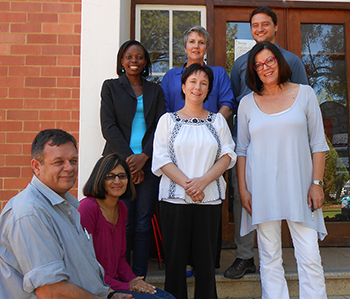Latest News Archive
Please select Category, Year, and then Month to display items
01 July 2021
|
Story Dikgapane Makhetha
|
Photo Supplied

This year, the young people of South Africa celebrated 45 years of the annual commemoration of
Youth Day. The University of the Free State (UFS)
Community Engagement (CE) office on the
Qwaqwa Campus has engaged a number of stakeholders in the call to use football as a means of bringing people together, transforming lives, and enthusing communities. Through partnerships, community organisations have great potential to create opportunities for breaking down barriers and inspiring social cohesion, initiating enablement through the development of social projects, and promoting education and health awareness.
On 16 June this year, local community organisations collaborated in the hosting of a soccer event for the youth of Qwaqwa at the FIFA Football for Hope Stadium in Tsheseng.
The Agape Foundation for Community Development,
Love Life,
Right to Care,
Youth in Action, Qwaqwa FIFA Project, and the Tsheseng Athletics Club were all stakeholders who diligently joined forces to ensure the successful launch of the tournament. Community development practitioners, who are trainees in the UFS Qwaqwa Department of Community Development, were garbed in departmental branded gear and have cautiously facilitated adherence to COVID-19 protocols. About 250 people, including football fans and participants, attended and enjoyed the entertaining games. Through the partnered recreational project, the Qwaqwa Campus CE office responded to the 2021 Youth Day theme: ‘Growing Youth Employment for an inclusive and transformed society’, by enhancing opportunities for networking among stakeholders. Football is popularly known for promoting transformational social projects in diverse communities across the globe.
Fighting the tuberculosis battle as a collective
2015-09-28

The team hard at work making South Africa a
healthier place |
Tuberculosis (TB) is second only to HIV/AIDS as the greatest killer worldwide due to a single infectious agent. More than 95% of TB deaths occur in low- and middle-income countries. Despite being more prevalent among men than women, TB remains one of the top five causes of death amongst women between the ages of 15 and 44 years. While everyone is at risk for contracting TB, those most at risk include children under the age of five and the elderly. In addition, research indicates that individuals with compromised immune systems, household contacts with pulmonary TB patients, and healthcare workers are also at increased risk for contracting TB.
According to the Deputy Director of the Centre for Health Systems Research and Development (CHSR&D) at the UFS, Dr Michelle Engelbrecht, research has found that healthcare workers may be three times more likely to be infected by TB than the general population.
The unsettling fact
“Research done in health facilities in South Africa has found that nurses do not often participate in basic prevention acts, such as opening windows and wearing respirators when attending to infectious TB patients,” she explained.
In response to this concern, CHSR&D, which operates within the Faculty of Humanities at the the University of the Free State (UFS) Bloemfontein Campus has developed a research project to investigate TB prevention and infection control in primary healthcare facilities and households in Mangaung Metropolitan.
Action to counter the statistics
A team of four researchers and eight field workers from CHSR&D are in the process of gathering baseline data from the 41 primary healthcare facilities in Mangaung. The baseline comprises a facility assessment conducted with the TB nurse, and observations at each of the facilities. Individual interviews are also conducted with community caregivers, as well as TB and general patients. Self-administered questionnaires on knowledge, attitudes, and practices about TB infection control are completed by all nurses and facility-based community caregivers.
Healthcare workers are the main focus of this research, given their increased risk of acquiring TB in healthcare settings. At clinics, interventions will be developed to improve infection control practices by both healthcare workers and patients. TB patients’ households are also visited to screen household contacts for TB. Those found to have symptoms suggesting TB infection are referred to the clinics for further assessment and treatment.
The findings of this study will serve to inform the development of an intervention to address TB prevention and infection control in primary healthcare facilities. Further funding will be sought to implement and evaluate the intervention.
Curbing future infections and subsequent deaths as a result of TB is the priority for the UFS. The cooperation and collaboration of the community, government, and sponsors will ensure that this project is a success, hence prolonging life expectancy.